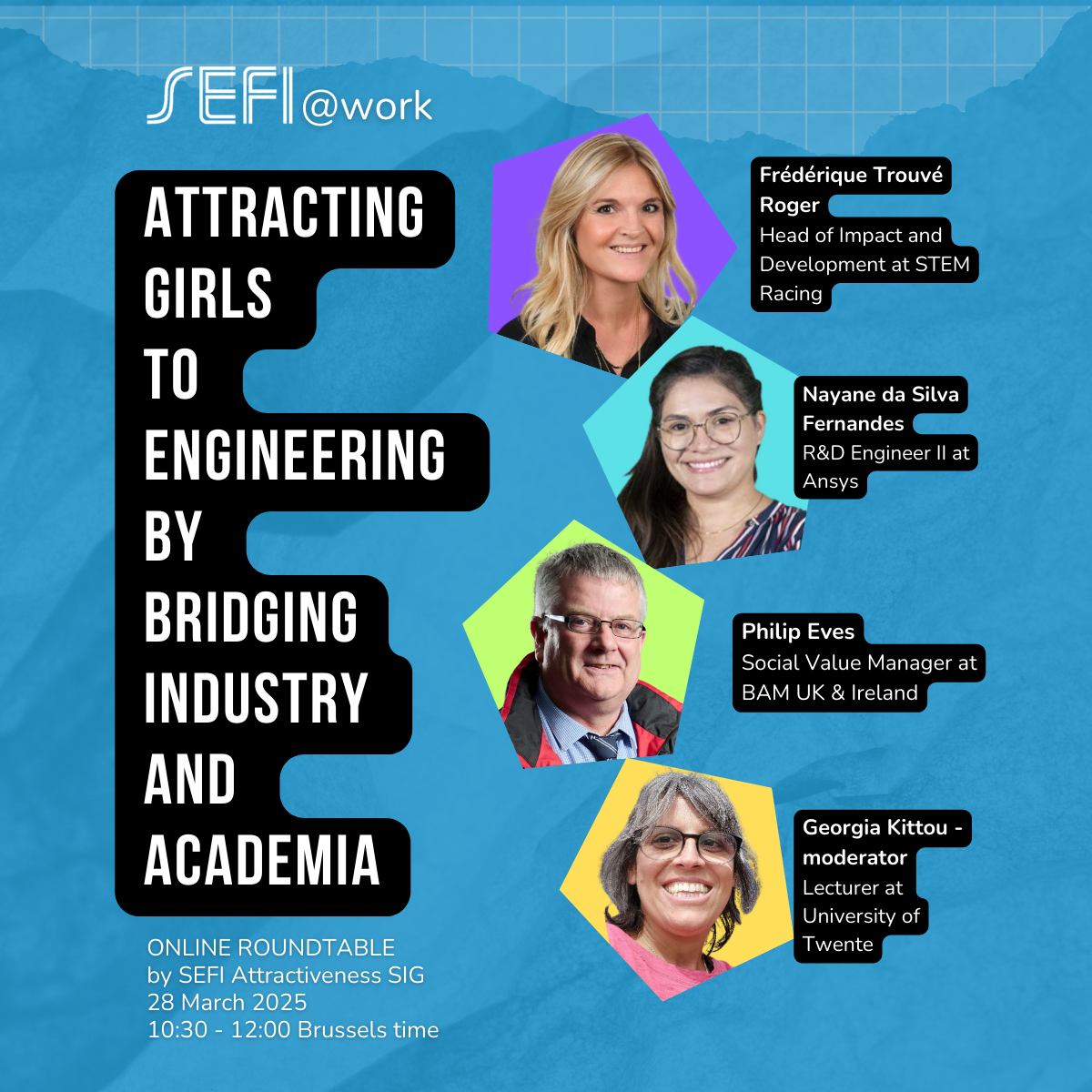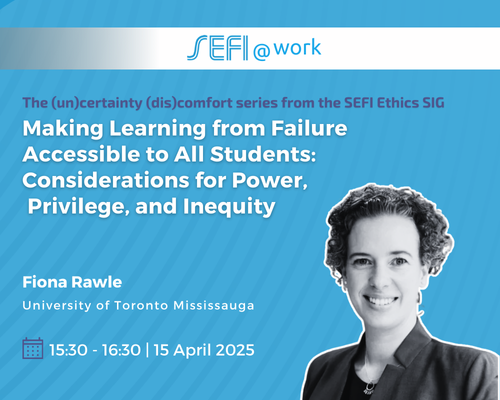Dear Members and Partners, We are pleased to share with you SEFI’s Strategic Plan for…
Bill Williams from IST Portugal on Research with Neil Cooke and Natalie Wint
What is engineering education research (EER)? Is it a distinct and credible field? Does it have strong enough theoretical foundations?

EER is a relatively young yet rapidly advancing field. Consequently, we’ve seen the emergence of journals, conferences, PhDs, funding opportunities, and professorships in just a few decades. This developing discipline has resulted in improvement in quality and the type of research conducted, thus impacting all engineering academics. For an engineering educator who wants to develop a research interest, successfully navigating this landscape requires insight from those who have witnessed and studied its formation.
In this episode we talk to Bill Williams who has helped to develop EER to a world-wide discipline over many years. Like many of those involved in EER, Bill’s background is in STEM, and he originally trained as a chemist at the National University of Ireland. Since then, he has worked in education in a variety of European and African countries. He serves as an associate editor of the European Journal of Engineering Education, published by SEFI and the Journal of Engineering Education, and has published numerous articles about the development of EER.
The rest of the article will summarise the key points discussed.
The start of global connectivity
Bill describes the first International Conference on Research in Engineering Education (ICREE) that aimed to bring together a global group of invited EER scholars. The event was hosted by JEE, supported by the U.S. National Science Foundation (NSF), and held in meeting space provided by the American Society for Engineering Education (ASEE). It aimed to address the challenge that “researchers in engineering education across the world are not sufficiently familiar with each other to facilitate collaboration on projects, nor have they reached sufficient consensus on expectations and norms for high quality research” (Borrego, Froyd, & Knight, 2007, p. 281).Although over half of the researchers invited to submit manuscripts for the conference were from outside the United States there was low non-U.S. participation (less than 25% of first authors). This was considered a result of the perception of several international attendees that U.S. reviewers had “imposed a narrow view of research accounting for the lower acceptance rate of international papers (50 percent vs. 65 percent)” (Borrego et al. 2007, p. 282). A related issue was research methodology, with U.S. scholars tending to favour quantitative approaches, while some non-U.S. participants stated that the US appeared to be biased against qualitative methods. This perceived bias led some of the attendees to conclude that more bridges between qualitative and quantitative researchers and methodologies needed to be built, to avoid separating EER into quantitative and qualitative communities, as had occurred in other disciplines. Bill explains how the value of such bridges has been recognized, and that today it is clear that JEE welcomes qualitative research studies.
Bill goes on to describe the successor to the ICREE (now titled the Research in Engineering Education Symposium (REES 2008) held in Davos, Switzerland, in the following year. This time the event was open to all researchers rather than just invitees and was hosted in Europe with the aim of involving more international scholars.
Use of citation and reference discipline analysis
Bill describes work he conducted in which the authors, citations and content of European Journal of Engineering Education (EJEE) and Journal of Engineering Education (JEE) in 1973 (JEE, 1975 EJEE), 1983, 1993, 2003, and available 2013 issues were analysed. Over this time period, he found that the number of citations rose (particularly of education and psychology sources), the percentage of research articles increased as did the number of reference disciplines. The number of papers per issue, the number of single author papers, and the citations of science and engineering sources decreased. EJEE was found to have a very broad geographic spread of authors while JEE authors were mainly US based.
Academic and Researcher Identity.
Bill refers to the work of Gardner and Willey who made use of a landscape model to describe engineering education as a knowledge domain that includes a variety of areas of endeavour. They conducted semi-structured interviews with nineteen conference participants and asked them to use one- or two-coloured adhesive stars to locate their conference paper on a model of the engineering education research landscape. The location of the stars was then analysed in relation to various elements of the model. They found that most stars were clustered in the ‘teaching and learning of engineering’ element or on one of the trajectories leading to it, this reflecting that their educational publications were linked with their teaching practice. Other elements in the model included engineering practice, engineering of education, and social research using educational theory. Bill explains how we can move between the elements depending on our project and interest at the time and says we should not be constrained to one area.
The European Context
Bill speaks about more recent work in which the EER landscapes in different European contexts were compared. This project involved analysing publications from each country to get a global picture. The UK and Spain were found to publish the most, something that Bill attributed to the ‘publish or perish’ culture. He goes on to describe a workshop held at SEFI 2022 whereby participants were asked about research groups, PhD programmes, funding, and reward in their own contexts. Bill explains that the overall picture is that there isn’t that much institutional or national funding, but there’s a number of groups or loose departmental centres, as well as individuals in some cases.
Future Work
Bill believes that future EER should focus on understanding the work of practicing engineering and bridging the gap between practice and education.
Canonical Texts
Bill recommends the following texts for anyone wanting to become more involved in EER.
- John Heywood. 2005. Engineering Education: Research and Development in Curriculum and Instruction. Comprehensive book covering the breadth of all knowledge at the time.
- 100th issue of JEE https://onlinelibrary.wiley.com/loi/21689830/year/2011 Commissioned articles by leaders in field.
- James Trevelyan (2014) The Making of an Expert Engineer. Discusses the bridge between engineering education and engineering practice.
- Cambridge Handbook of Engineering Education Research https://www.cambridge.org/core/books/cambridge-handbook-of-engineering-education-research/D2056F1ABBE32AEEB898BCAC611AC559
- International Handbook of Engineering Education Research https://www.taylorfrancis.com/chapters/oa-edit/10.4324/9781003287483-1/introduction-international-handbook-engineering-education-research-iheer-aditya-johri
Bill also gives the advice to speak to people and make connections at conferences, particularly with those whose work you admire.
Resources
- A guest editorial in JEE that provides highpoints of ICREE.
Borrego, M., Froyd, J., & Knight, D. (2007). Accelerating emergence of engineering education via the International Conference on Research in Engineering Education (ICREE). Journal of Engineering Education, 96(4), 281–282.
https://onlinelibrary.wiley.com/doi/10.1002/j.2168-9830.2007.tb00938.x
These papers present findings are from a series of moderated interactive sessions held at the AGCEER international engineering education conferences between July 2007 and December 2008, where attendees discussed the current state and future trajectory of engineering education research.
- Jesiek, B. K., M. Borrego, and K. Beddoes. 2010. “Advancing Global Capacity for Engineering Education Research: Relating Research to Practice, Policy, and Industry.” Journal of Engineering Education 99 (2), 107–119.
https://onlinelibrary.wiley.com/doi/abs/10.1002/j.2168-9830.2010.tb01048.x
Jesiek, B. K., M. Borrego, and K. Beddoes. 2010. “Advancing Global Capacity for Engineering Education Research: Relating Research to Practice, Policy and Industry.” European Journal of Engineering Education 35 (2), 117–134.
- This paper summarises the authors, citations and content of European Journal of Engineering Education (EJEE) and Journal of Engineering Education (JEE) in 1973 (JEE, 1975 EJEE), 1983, 1993, 2003, and available 2013 issues.
Wankat, P., Williams, B. & Neto, P. (2014). Engineering education research in European Journal of Engineering Education and Journal of Engineering Education: citation and reference discipline analysis, European Journal of Engineering Education, 39(1) 7-17.
https://www.tandfonline.com/doi/abs/10.1080/03043797.2013.867316
- This paper provides a brief history of efforts to make engineering education research global. It provides information about AGCEER workshops and ICREE and REES initiatives and we draws on empirical data to analyze progress towards globalization.
Williams, B. and Wankat, P. (2016). The Global Interconnections of Engineering Education Research. J. Eng. Educ., 105, 533-539.
https://onlinelibrary.wiley.com/doi/epdf/10.1002/jee.20131
- This paper describes the application of citation analysis to research presented in four publication venues: the annual conferences organised by ASEE (American Society of Engineering Education) and SEFI (European Society of Engineering Education) and two archival journals published by these two societies: Journal of Engineering Education (JEE) and European Journal of Engineering Education (EJEE). The findings showed that citations in ASEE conferences are dominated by sources with US affiliations, whereas the SEFI data showed that while US sources were frequently cited, European and other authors were also well represented. With regard to the journals JEE and EJEE, a similar pattern was observed.
Williams, B. Wankat, P. & Neto, P. (2018) Not so global: a bibliometric look at engineering education research, European Journal of Engineering Education, 43(2) 190-200.
https://www.tandfonline.com/doi/abs/10.1080/03043797.2016.1153043
- This paper uses a landscape model to describe engineering education as a knowledge domain that includes a variety of areas of endeavour.
Gardner, A. & Willey, K. (2013) Mapping the engineering education research landscape in Australia, Proceedings of the 2013 AAEE Conference, Gold Coast, Queensland, Australia
- This paper uses the identity-trajectory framework to analyse the discourse of 19 engineering academics in relation to their educational research. The findings reveal insights into the identity changes experienced in the transition from typical engineering academic to engineering education researcher.
Gardner, A. & Willey, K. (2018) Academic identity reconstruction: the transition of engineering academics to engineering education researchers, Studies in Higher Education, 43:2, 234-250.
https://www.tandfonline.com/doi/full/10.1080/03075079.2016.1162779?scroll=top&needAccess=true

